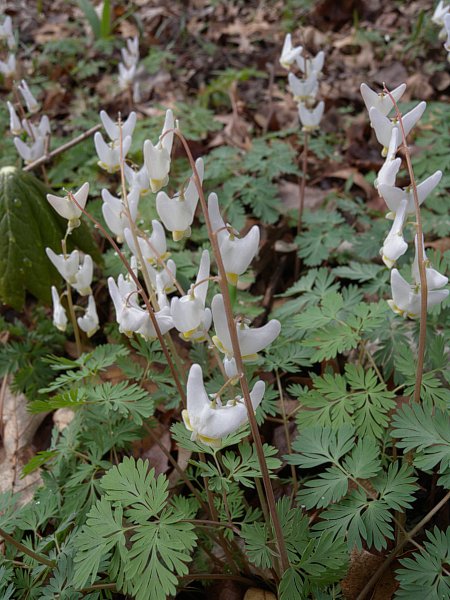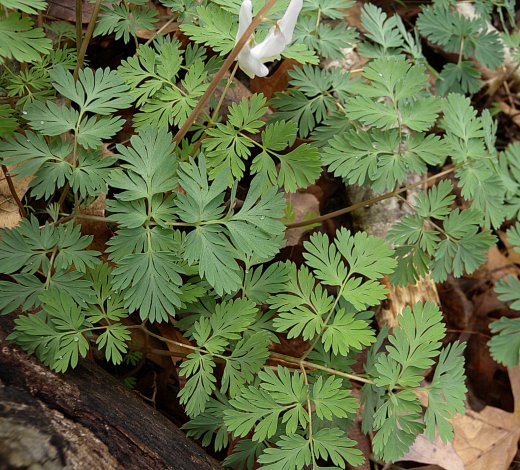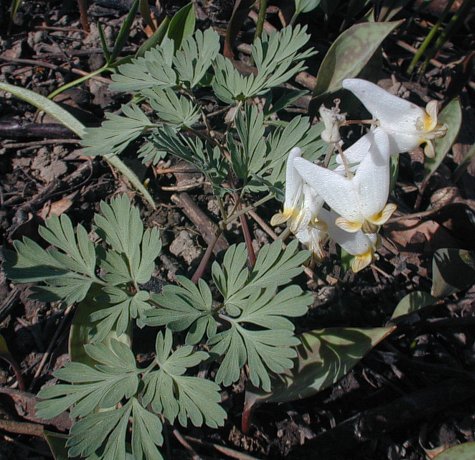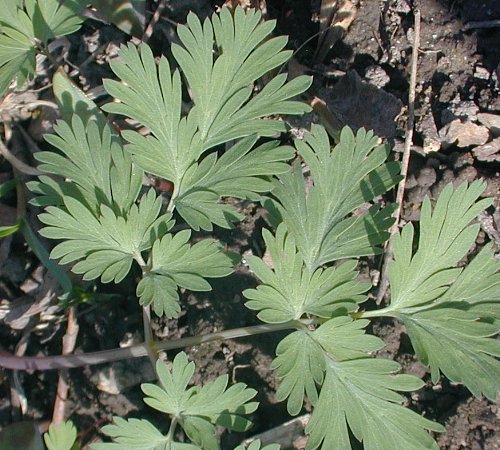Description: This herbaceous perennial plant is about 4-8" tall. It consists of a rosette of basal leaves spanning about 6" across. These basal leaves are greyish green to green and glabrous. Each of these leaves is ternately compound and divided into 3 primary leaflets, while each primary leaflet is divided into 3 secondary leaflets. These secondary leaflets are pinnately cleft into linear or oblanceolate lobes. The long petioles of the compound leaves are slender and glabrous; they are pale red, tan, or brown. From the center of the rosette, there develops a semi-erect raceme of 2-6 pairs of white flowers on a long peduncle (flowering stalk). This raceme tends to bend to one side, while the flowers droop upside-down from their pedicels. Both the peduncle and pedicels are pale red or yellowish brown, terete, glabrous, and sometimes glaucous. The pedicels are about ¼" in length; in the middle of each pedicel, there is a pair of tiny linear bracts.

Each flower is about ¾" long and assumes the form of an upside-down Dutchman's Breeches, hence the common name of the plant. It consists of 2 outer petals that are white and 2 inner petals that are pale yellow. The two outer petals form two nectar spurs that are long and spreading; they are joined together at the base. The two inner petals are much smaller and form the base of the flower; they have small wings that curl upward. The 2 sepals of each flower are white and more or less ovate in shape; they are much shorter than the petals. The blooming period occurs from early to mid-spring and lasts about 2-3 weeks. There is no noticeable floral scent. The flowers are replaced by oblongoid-ovoid seed capsules that taper into points at both ends. These capsules eventually split apart into 2 segments to release their seeds. The root system consists of a bulbous base with fleshy scales and secondary roots.

Cultivation:
The
preference is dappled sunlight of woodlands, mesic conditions, and a
fertile loamy soil with abundant organic matter. This plant develops
early and can resist moderate frost without damage.
Range & Habitat:
Dutchman's Breeches is a common plant that occurs in nearly every
county of Illinois (see Distribution
Map), where it is native. Habitats include deciduous
mesic woodlands, especially along gentle slopes, ravines, or ledges
along streams. This species occurs in original woodland that has never
been plowed under or bulldozed over. It's abundance in such woodlands
can be highly variable – from uncommon to common.

Faunal
Associations:
The nectar of the flowers attracts long-tongued bees primarily,
including honeybees, bumblebees, mason bees (Osmia spp.), and
Anthophorid bees (Anthophora
ursina, Synhalonia
spp., Habropoda
laboriosus). Less common visitors include short-tongued
Andrenid bees (Andrena
spp.), Bombylius major (Giant Bee
Fly), various butterflies, and skippers. The butterflies and
skippers are not effective cross-pollinators of the flowers. Because
the seeds have elaisomes (fleshy or oily appendages), they are
distributed by ants. Ants carry the seeds to their nests, eat the
elaisomes, and discard the seeds some distance from the mother plant.
The foliage is toxic to mammalian herbivores and it is not often eaten
by
them.
Photographic Location:
A mesic area of Busey Woods in Urbana, Illinois, and an upland
woodlands in McLean County, Illinois.

Comments: This is a delightful spring wildflower of woodlands – both the flowers and foliage are attractive. Dutchman's Breeches is one of the earlier woodland wildflowers to bloom. The only other species with a similar appearance is Dicentra canadensis (Squirrel Corn). Squirrel Corn also occurs in mesic deciduous woodlands and blooms only a little later than Dutchman's Breeches. The nectar spurs of Squirrel Corn are shorter and more rounded than those of Dutchman's Breeches, and its white flowers are fragrant. It also has a root system that produces small edible tubers. Within the Fumitory family, Dicentra spp. differ from Corydalis spp. by the structure of their flowers – the former have flowers with 2 nectar spurs, while the latter have flowers with a single nectar spur.